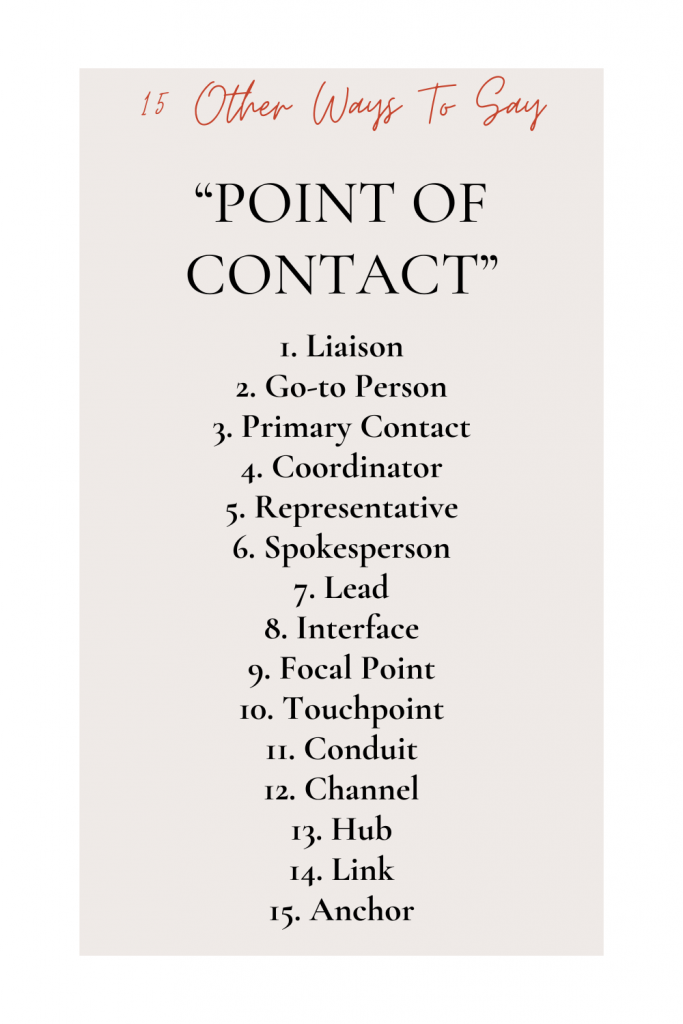In the world of business and communication, the term “point of contact” is often used. Refers to a person or department that serves as a coordinator or focal point of information about an activity or program. In this article, we will explore these alternatives to diversify your vocabulary and make your communication more dynamic.
Other Ways to Say “Point of Contact”
When you repeatedly use the same term, it can become monotonous and lose its impact. Knowing other ways to say “point of contact” can add variety to your conversations and written communications.
1. Liaison
Example: “Jane will be our liaison for this project.”
Meaning: A liaison typically serves as a bridge between two distinct groups or entities, ensuring smooth communication and collaboration. They often have a deep understanding of both sides and can translate needs, concerns, or information effectively.
2. Go-to Person
Example: “For any queries about the event, Mark is the go-to person.”
Meaning: This term refers to someone who is consistently reliable and knowledgeable in a specific area. They’re the person everyone “goes to” when they have questions or need guidance on that particular topic.
3. Primary Contact
Example: “Please list your primary contact for billing inquiries.”
Meaning: This is the main individual designated for communication or inquiries. They are the first point of reference and are typically well-versed in the subject matter at hand.
4. Coordinator
Example: “Lucy is the coordinator for our charity event.”
Meaning: A coordinator is responsible for organizing and managing various elements of a project or event. They ensure that all parts come together seamlessly and that objectives are met.
5. Representative
Examples: “If you have any concerns, please speak to our customer service representative.”
Meaning: Acting on behalf of a larger group or organization, a representative embodies the values, objectives, and interests of that entity. They are authorized to speak or make decisions in their name.
6. Spokesperson
Example: “The company’s spokesperson will address the media tomorrow.”
Meaning: Typically used in public relations contexts, a spokesperson is chosen to communicate on behalf of an organization or group, especially to the media. They present a curated message and handle inquiries.
7. Lead
Example: “Brian is the lead for our software development team.”
Meaning: In a team or project context, the lead holds primary responsibility. They guide the direction, make pivotal decisions, and often have a significant role in its execution or management.
8. Interface
Example: “Rita will be our interface with the client.”
Meaning: An interface acts as a point of interaction between two systems, groups, or entities. They ensure that communication flows smoothly and that any issues or concerns are addressed promptly.
9. Focal Point
Example: “For all marketing-related queries, Derek is the focal point.”
Meaning: This term denotes centrality. The focal point is where attention or activity is concentrated, making it a primary source of information or action.
10. Touchpoint
Example: “Reach out to Tina; she’s our touchpoint for this campaign.”
Meaning: A touchpoint represents a stage or aspect of a process. In customer service, for instance, a touchpoint might be any interaction a customer has with a business.
11. Conduit
Example: “For any partnership opportunities, Alex is the conduit.”
Meaning: A conduit acts as a channel or pipeline, facilitating the flow of information or resources between two points. They ensure that what’s transmitted is received accurately and efficiently.
12. Channel
Example: “For feedback on the new software, please use Sarah as the channel.”
Meaning: Similar to a conduit, a channel is a pathway or medium through which something is conveyed. It can be a formal or informal route of communication or distribution.
13. Hub
Example: “Our support hub for this issue will be Jason.”
Meaning: A hub is a central point in a network or system from which other points can be accessed. It’s a core from which activities radiate, making it essential for coordination and communication.
14. Link
Example: “For collaborations, Clara is our main link.”
Meaning: A link serves as a connector between two or more entities, ensuring they remain integrated. It can be a person, a system, or a tool that binds elements together.
15. Anchor
Example: “For all your concerns about the project, Martin will be your anchor.“
Meaning: An anchor provides stability and assurance. In a team or project, the anchor is a steadfast and reliable point, ensuring that even amidst challenges, the core objectives remain secure.

When to Use Different Expressions
Important to know is that the alternative you choose for “point of contact” should fit the context:
Formal Settings
In official documents or formal communications, terms like “primary contact” or “representative” might be more appropriate.
Casual or Internal Communications
For less formal situations or internal team discussions, “go-to person” or “lead” can be more fitting.
Public Relations
When dealing with the media or public statements, “spokesperson” is the preferred term.
Events or Projects
If someone is in charge of organizing or ensuring the smooth operation of an event or project, “coordinator” is a suitable term.
Conclusion
Just as diversifying your well-wishes can add a personal touch to your messages, knowing other ways to say “point of contact” can make your business communications more engaging. Whether you’re drafting an email, preparing a presentation, or speaking in a meeting, having a varied vocabulary will always serve you well.
For those interested in expanding their business vocabulary or improving their communication skills, platforms like LinkedIn Learning offer a range of courses tailored to professionals. Dive in and discover the power of words!
FAQs
1. What exactly does “Point of Contact” mean?
Answer: “Point of Contact” refers to a person or department serving as the coordinator or primary source of information for a particular activity or program. It’s the go-to individual or team for specific queries or tasks.
2. Is “Point of Contact” a formal term? Can it be used in official documents?
Yes, “Point of Contact” is a formal term and is commonly used in official documents, contracts, and business communications to specify whom to reach out to for specific information or issues.
3. Can “Point of Contact” be abbreviated?
Yes, it’s often abbreviated as “POC.” However, in formal documents or communications, it’s advisable to use the full term first and then indicate the abbreviation in parentheses, like “Point of Contact (POC),” if you plan to use the abbreviation later in the document.
4. Is it correct to have multiple Points of Contact for a single project or task?
While it’s common to have one primary Point of Contact, larger projects or tasks might require multiple POCs, especially if they cover different areas or departments. In such cases, it’s essential to specify the responsibilities or domains of each POC.
5. Is “Point of Contact” only used in business settings?
While commonly used in business, the term can also apply to other contexts, such as events, academic projects, or community activities, where there’s a need to specify a primary person for communication or coordination.
6. Can a department or a team be a “Point of Contact” or is it only an individual?
Both an individual and a department/team can serve as a Point of Contact. The key is that whoever or whatever is designated as the POC should be equipped to handle inquiries and provide the necessary information or assistance.
7. How is “Point of Contact” different from “Liaison”?
While both terms refer to a person who facilitates communication, a “Liaison” often implies a two-way communication role between two parties, ensuring mutual understanding and collaboration. In contrast, a “Point of Contact” might be more one-sided, primarily serving as a source of information or assistance for one party.









